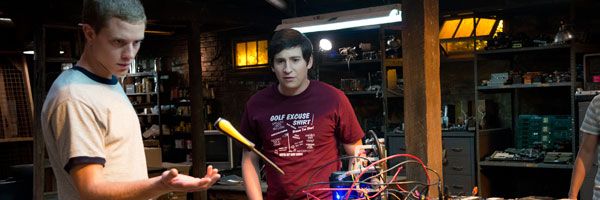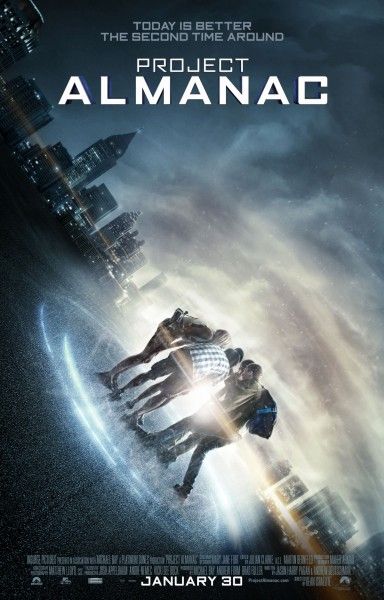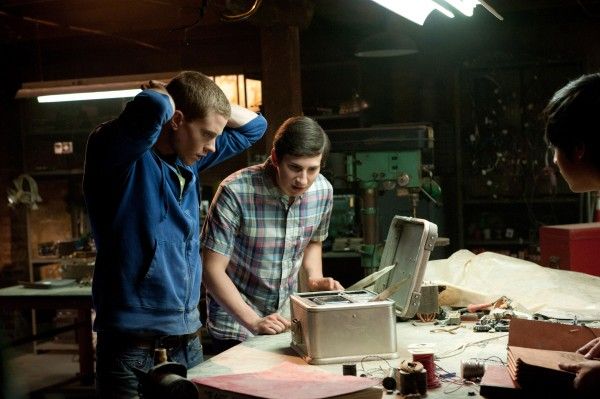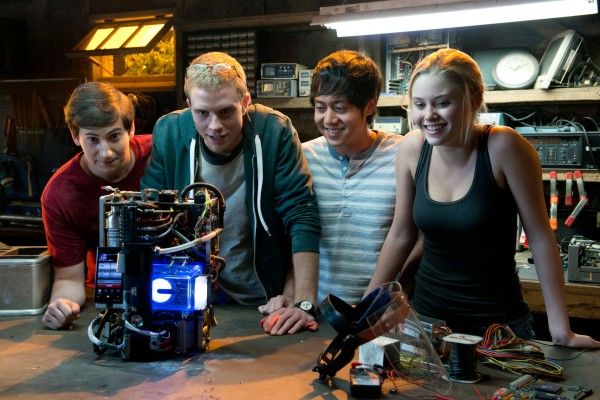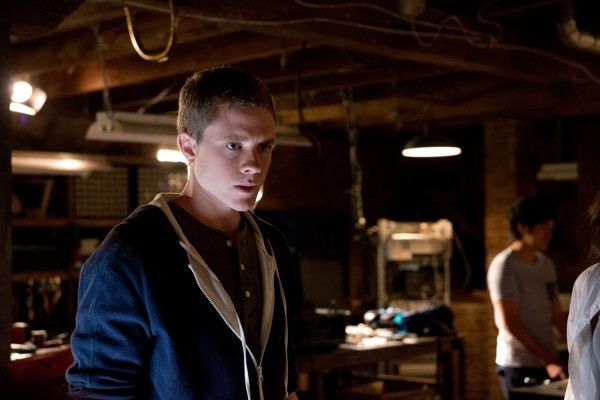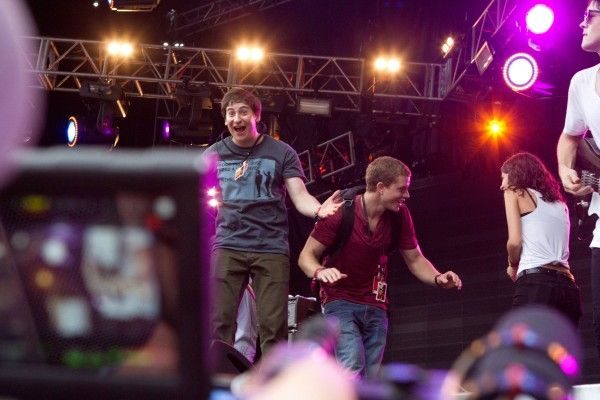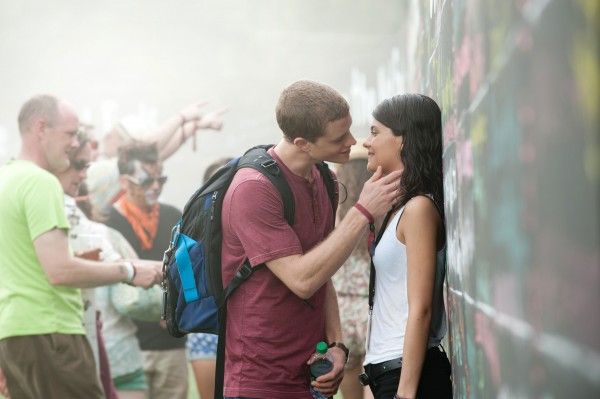I had the pleasure of catching a screening of Dean Israelite’s feature directorial debut, Project Almanac, back at San Diego Comic Con and while the entire film is a blast, one of the most impressive components of it is the surprisingly grounded version of time travel. The main characters don’t just zap themselves into the past with a neat VFX trick. Israelite and his team came up with a precisely designed time machine made up of very familiar items and then they show you how it affects real world environments in a wildly detailed, well-thought-out manner.
Want to know more about the Project Almanac time machine and how it works? Hit the jump to check out my on-set roundtable interview with Israelite on that, his shooting style, the casting process and more. Project Almanac is due in theaters on January 30th.
Question: Brad [Fuller] was telling us about when he first read the script and that they wanted you to do a presentation. What was your vision for this movie when you first read the script?
DEAN ISRAELITE: I always thought that the movie had to be really raw, very edgy, that everything had to be super grounded and feel very real. If this was going to be a story about kids discovering time travel and building a time machine that we needed to believe that they really did it and so the thing that I made I shot for five hours in my apartment just with a bunch of friends and did some VFX in a day, but because it was so roughly put together, and I wasn’t even sure it was ever going to work - I decided to do it on a Tuesday, I got friends to help me out, we were shooting it on Friday and I was finished with it on the Saturday. For that whole time I was sure it was never going to work, but I think that the nature of putting it together that quickly, having it that rough, having it that raw actually showed me what the film could be and what’s exciting about the movie. From day one my take on the movie has been grounded, real, raw, and in terms of the kids and what they bring to it, a real sort of recklessness and a youth and a joy to all of that.
I hear the audition process was really long. How did you decide that these were the four?
ISRAELITE: I decided that these were the four in December after we had gone through I think a month of auditions. Ginny [Gardner] was the last person to get cast, but the four others I sort of knew that I wanted them in the film from December and it just took a long time to sort of go through and really show the studio a bunch of different auditions, a bunch of different takes of them doing things, a bunch of their chemistry together. And I respect that the studio wanted to be very sure that these were the kids and to the kids’ credit, they were put through the ringer and for five months they stuck with it and were cast in the end and they were always the best through the whole process and I think it was us also trying to find what the voice of the movie was, but it’s really a credit to the actors because they stuck with a lot of doubt.
What are some of the pitfalls of directing a time travel movie?
ISRAELITE: I guess the hard part is more in the development stage when we’re writing it. The logic is hard. You come up with a great idea and you get all excited that it’s going to work and then you go down two hours and then one guy turns to everyone and goes, ‘Wait, that makes absolutely no sense because if he was there, then this wouldn’t have happened, then this,’ and it completely implodes. So I think the biggest challenge was really two fold. I think it was being respectful to the logic, but then also being able to let some of the logic go when the emotion of that was more important or the fun of that needed to be more important. What does the audience really know at this point or really care about at this point? You don’t want to disrespect the audience’s intelligence either, so I think the push and pull between those two things is challenging and then just directorially what was challenging was coming up with what time travel will look like. This is a found footage movie, to me what was more interesting about what the opportunity with this was, how will time travel affect the camera? How do you dramatize time travel when it’s so super subjective and when you are completely in the point of view of the characters? What does that mean to the camera? What does that mean to the technology of the camera? I think we have cool concepts and all of that, but we’re still exploring all of that and to me again, it was just trying to make it as real as possible, as non sort of big sci-fi as possible.
So what does time travel look like? What is the idea that guides that?
ISRAELITE: The idea, what I’ll say without giving too much away - and also we’ll continue to find it in post - but the idea is that I hope it will feel very subjective and very raw and very real and very difficult. One of my first impressions in reading the script was that I think the experience of time travel needed to be harder. I’m South African so I fly to South Africa all of the time and I’m totally f*cked up after a 24-hour flight. I’m totally f*cked up when I get there and I haven’t time travelled, so If I’m f*cked up just going on a plane, what are these characters going to feel like when they go back in time? That was sort of the launchpad for the concept behind every element that’s involved in how we’re trying to shoot it and how the characters are performing and what’s going to happen to the camera and the editorial, all that.
What will it look like visually? Is the camera going to cut to black, then come back on and we’re in another time?
ISRAELITE: No, I hope not. It’s going to be very elemental, meaning - I’m also not sure how much I’m allowed to say or not say. The concept behind it is that it really affects the environment in adverse ways, so when you turn the time machine on there’s gonna be a whole bunch of chaos. There’s going to be weightlessness involved, because it gives out sort of this electromagnetic energy all of the metal objects around you start to levitate, a bunch of stuff just starts to shake, there’s shockwaves that emanate out form the time machine and so from within the group it emirates out, when you’re outside it’s almost like this huge storm starts to brew. Things speed ramp, but again all of the chaos is grounded in real elements in the scene, so when they’re down in the basement and they turn the time machine on, all the tools start to levitate and spin and the glass starts to shatter and then freeze and then maybe go backwards and reform itself. The camera starts to levitate because it’s metal, so when it’s unmanned, it starts to sort of take on a life of its own and the characters have to yank it out of mid air. Their hair starts to stand up on end because it’s all this static electricity. We just shot a scene where they unscrew a light bulb, but the light bulb stays on because it’s giving out all of this electromagnetic energy and then when they time jump outside, there’s going to be shockwaves that hopefully will feel like almost a bomb blast went off in the middle of the group kicking up all of this dust and debris toward the lens. The time machine is very chaotic and everything that the time machine affects is grounded in the real world things that we’ve seen. I’m sure we’ll have some kind of light gag going on, but I’m hoping that there isn’t anything kind of out of the real world playing in that scene, so no sort of weird blue thing or some kind of portal that you walk through. It’s the regular world reacting in irregular ways.
Can you tell us anything about what the time machine itself looks like?
ISRAELITE: What’s cool about the time machine is that it’s very kludged together, sort of MacGyver-ed together and they create it from parts from Home Depot and stuff they found in their basement. And what’s cool about it is they can’t afford - they find all of these blue prints, these schematics from 12 years ago that were put together by DARPA, but they don’t have the money or the resources to build the machine that’s laid out, so they have to improvise their own sort of ghetto version of the time machine and that’s why the time machine has limited power and can only take them back a few days and then a few weeks, which I also think is cool about the movie. It’s a movie about time travel, but you can only go back two days. So it’s sort of like this high concept treated in a very low-fi way and so that logic applies to how they’re building the machine as well. They improvise parts from the basement from what the dad has left for them just in terms of all of these other thing that he was experimenting with. They go to a hardware store and buy other things and the time machine becomes this MacGyver-ed thing that has recognizable kids stuff in it, like an Xbox. They needed to get the graphics processor from the Xbox in order to read the code that was on the glass circuit, so there’s an Xbox wired into it, there’s lots of other processors. But what I tried to do when I designed it with the guys from Legacy was make things on this machine totally recognizable, so you see ribbon cables that we all recognize. You see the Xbox somehow configured into the mix. You see processors that would be in your own computer. In finding the stuff from what the dad left, they find all of these schematics, but they also find this glass circuit, which is the heart of the machine and has all of the technology needed really to time travel and what they need to do is interpret the data that’s on that glass circuit and give it enough power. So the glass circuit is essentially kind of like the flux capacitor, but they need to extract the information from it, so they’ll need the graphics processor from the Xbox to extract the information from it. So the machine is built around trying to feed information into this glass circuit and get information out of the glass circuit, and in designing it we really tried to come up with a logic of, this glass circuit is here, this is interfacing with the graphics processor, the graphics processor interfaces with these CPU processors and that all finally interfaces with they need a little bit of hydrogen, because they need fusion to go time traveling. What finally happens once you charge the machine up and get enough power to it, extract the data from the glass circuit that then goes into their smart phone. They’ve created an app on their smart phone based on the data in the glass circuit. They’ve extracted that data, created an app on their smart phone that they can now plug in the day and date that they want to go back to. All of that stuff is interfacing with each other and once the machine becomes powered enough, then it pulls hydrogen from a small canister of hydrogen that they had to steal from their school and it pulls hydrogen into the glass circuit and in the glass circuit the fusion reaction takes place and you go time traveling.
With this movie you’re also entering the found footage space which has exploded lately, but the grammar of the filmmaking is still not set in stone. Tell me about your thought process of what you want to bring to this and how you’re wrapping your mind around how to accomplish it.
ISRAELITE: I think what’s exciting about doing it as found footage - if we all are being honest, found footage gets a little bit of a bad rap sometimes, but I think that there’s a lot of potential in the medium in taking it seriously and in treating the audience with respect and in treating the characters with respect in terms of, why is the camera really on? Where would the camera be when it is on? But more than that, I think when the found footage starts to fall apart a little bit is when it just becomes generic hand held, when it just becomes, ‘Well, we’ve said that a character is filming and now we’ve done that work and now all we have to do is kind of shoot it as a handheld movie.’ To me, constructing the look of the movie with Matt Lloyd, the DP, it was all about, what are the opportunities visually that [this] allows you? Meaning, sometimes you are framing things that are completely off screen, so the camera gets sat down on a table and you’re just hearing the characters. That could be more exciting than seeing all of it all of the time. Sometimes the camera will get handed off from one character to another and then it will aesthetically look different because that character has a different aesthetic to the other character, but I think what we’ve tried to do is always motivate the camera in a way that makes sense. But try and use it in a way that then allows you to photograph the movie in such a way that those shots are helping tell the story in a cool way. So if you look at something like Cloverfield, to me what’s so successful about Cloverfield is it’s a monster movie where you’re allowed to not show the monster. In fact, it’s cooler that you don’t show the monster because if you started to cut to a whole bunch of coverage of the monster with huge crane shots, I think it would take the authenticity away from what that movie was and so I think we have that same kind of opportunity in this where the camera doesn’t catch things. The camera gets put in places where you wouldn’t be allowed to put the camera in a conventional movie and what can that then bring to the whole feeling of time travel?
We were watching you shoot and you were changing everything constantly with all of those background extras. What tools do you come to set with and do they stand?
ISRAELITE: We’ve shot-listed the entire movie. We are very prepared to be honest in terms of what we’ve wanted to get out of every scene, and by in large the camera has been placed where we wanted it to be placed and it has started to work out and some times you put the camera down and the scene isn’t working so you have to find an alternative, just like a regular movie. But I think, to me, it’s not my process, but to me coming in with no plan I think would then just make us fall into a generic aesthetic. Coming in with, where is it cool to put the camera down that feels authentic, that treats the audience with respect in terms of being found footage, but that also gives the audience a visually dynamic, pleasing, dramatic telling of the story. So we’re very prepared because I think those shots have to be thought of ahead of time.
How wide was that shot you were just shooting? We didn’t see it on the monitor.
ISRAELITE: We’re on very long lenses on that stuff, so we see full body of them and then we go into really tight close-ups of them as well.
Can you tell us about the scene you’re shooting today? We know that they travel back while they’re supposed to be in school to some concert, but is it important to the emotional core of the movie?
ISRAELITE: This scene is pivotal. To me what’s awesome about this movie is that it has all of these big ideas, has a cool approach to it in the fact that it’s found footage and treating this high concept in that way, but it also has real heart between all of these characters and I think it’s a coming of age story and a love story and it’s all built in really wonderfully into the material and this is sort of a pivotal scene in that where our main character has built this time machine with all of his friends, they’re gone on this journey of wish fulfillment doing all of this stuff, winning the lottery, paying off their houses, just doing great, cool sh*t and they miss this huge music festival because they didn’t have the money for it and now they get the opportunity to ditch class. They’re all meant to be in chemistry right now. They ditch class and come to this huge music festival and this is the scene where the protagonist is about to make his movie on the girl and he tries to and she opens the door for him and at the very last minute, he’s too scared to sort of take the bull by the horns and lean into her because that’s been his problem the whole movie. And so this is a scene where you feel that these two are going to finally come together and he blows it. And it sets up the second half of the movie about what he’ll have to do and the places he will have to go and the rabbit hole he will have to go down in order to get the girl, and all the moral compromises he will make to try and get that.
Who’s holding the camera?
ISRAELITE: Right now it’s the sister who is really sort of by in large the camera person for the movie. They find their dad’s old video camera up in the attic and that then becomes the impetus for her to be filming the whole movie.
The actors were saying that they’ve enjoyed a good amount of freedom as far as improvising goes. Is that very important to this story or is more connected to your directing style?
ISRAELITE: It’s probably less indicative of my directing style. We’ve done a lot of improv in rehearsal. I’m a big believer in rehearsal and a big believer in the actors being able to find the material themselves and identify with the beats themselves without us having to stick to the actual language of the script, just for them to understand what each scene is about. It’s been a combination on this movie. I like to get the scene as it’s written because I think it’s written well, and then I like to allow them the freedom to make it their own and scrappy it up, and it’s been a total combination of those two things.
Check out even more from my Project Almanac set visit:

